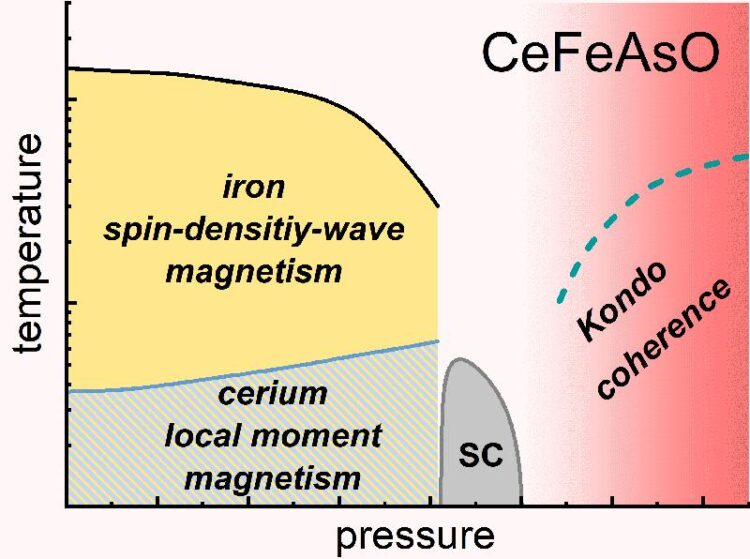Connecting two classes of unconventional superconductors

Schematic temperature-pressure phase diagram of CeFeAsO. © MPI CPfS
The understanding of unconventional superconductivity is one of the most challenging and fascinating tasks of solid-state physics. Different classes of unconventional superconductors share that superconductivity emerges near a magnetic phase despite the underlying physics is different. Two of these unconventional materials are the heavy-fermion and the iron-based superconductors.
Researcher from the Max Planck Institute for Chemical Physics of Solids applied large hydrostatic pressures to tiny single crystals of CeFeAsO, a non-superconducting parent compound to iron-based superconductors, using diamond anvil pressure cells.
By electrical, magnetic and structural measurements they showed that upon increasing the applied pressure, the material characteristics change from that of an iron-pnictide material to that of a heavy-fermion metal. Surprisingly, a narrow superconducting phase emerges in the boundary region between the typical iron-pnictide spin-density-wave magnetism and a Ce-based Kondo-regime.
This suggests that the two major phenomena characterizing iron-pnictides and heavy-fermions, spin-density-wave magnetism and the Kondo-effect, work together to produce superconductivity in CeFeAsO.
This work is published in Physical Review Letters and has been selected by the editors to be a PRL Editors’ Suggestion. Only about one Letter in six is chosen for this highlighting.
Wissenschaftliche Ansprechpartner:
Michael.Nicklas@cpfs.mpg.de
Originalpublikation:
K. Mydeen, A. Jesche , K. Meier-Kirchner, U. Schwarz, C. Geibel , H. Rosner, and M. Nicklas. Electron Doping of the Iron-Arsenide Superconductor CeFeAsO Controlled by Hydrostatic Pressure. Phys. Rev. Lett. 125, 207001 (2020),
DOI: 10.1103/PhysRevLett.125.207001
https://www.cpfs.mpg.de/3256761/20201111b
https://www.cpfs.mpg.de/de
Media Contact
All latest news from the category: Physics and Astronomy
This area deals with the fundamental laws and building blocks of nature and how they interact, the properties and the behavior of matter, and research into space and time and their structures.
innovations-report provides in-depth reports and articles on subjects such as astrophysics, laser technologies, nuclear, quantum, particle and solid-state physics, nanotechnologies, planetary research and findings (Mars, Venus) and developments related to the Hubble Telescope.
Newest articles

High-energy-density aqueous battery based on halogen multi-electron transfer
Traditional non-aqueous lithium-ion batteries have a high energy density, but their safety is compromised due to the flammable organic electrolytes they utilize. Aqueous batteries use water as the solvent for…

First-ever combined heart pump and pig kidney transplant
…gives new hope to patient with terminal illness. Surgeons at NYU Langone Health performed the first-ever combined mechanical heart pump and gene-edited pig kidney transplant surgery in a 54-year-old woman…

Biophysics: Testing how well biomarkers work
LMU researchers have developed a method to determine how reliably target proteins can be labeled using super-resolution fluorescence microscopy. Modern microscopy techniques make it possible to examine the inner workings…





















